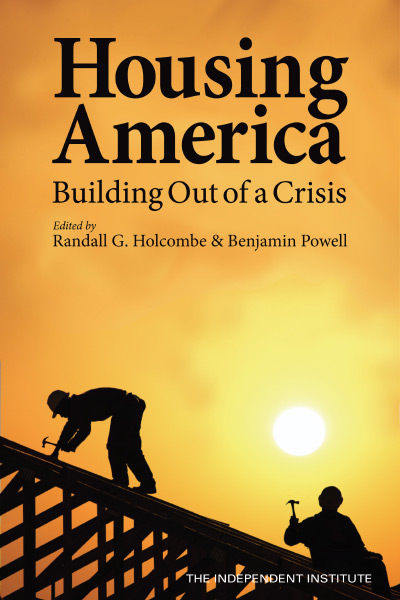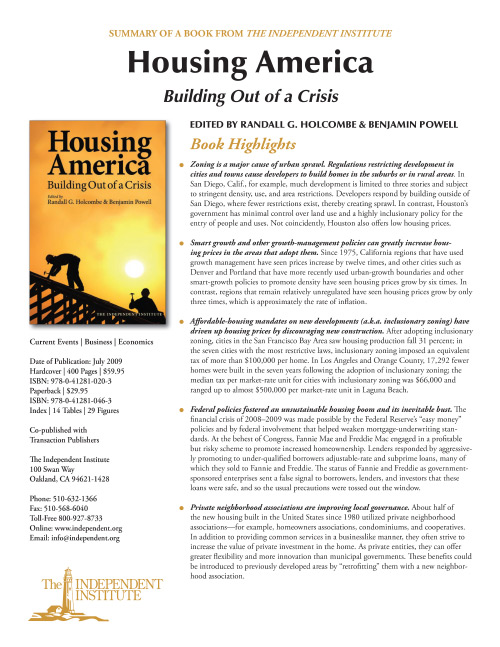Highlights
- Zoning is a major cause of urban sprawl. Regulations restricting development in cities and towns cause developers to build homes in the suburbs or in rural areas. In San Diego, Calif., for example, much development is limited to three stories and subject to stringent density, use, and area restrictions. Developers respond by building outside of San Diego, where fewer restrictions exist, thereby creating sprawl. In contrast, Houston’s government has minimal control over land use and a highly inclusionary policy for the entry of people and uses. Not coincidently, Houston also offers low housing prices.
- Smart growth and other growth-management policies can greatly increase housing prices in the areas that adopt them. Since 1975, California regions that have used growth management have seen prices increase by twelve times, and other cities such as Denver and Portland that have more recently used urban-growth boundaries and other smart-growth policies to promote density have seen housing prices grow by six times. In contrast, regions that remain relatively unregulated have seen housing prices grow by only three times, which is approximately the rate of inflation.
- Affordable-housing mandates on new developments (a.k.a. inclusionary zoning) have driven up housing prices by discouraging new construction. After adopting inclusionary zoning, cities in the San Francisco Bay Area saw housing production fall 31 percent; in the seven cities with the most restrictive laws, inclusionary zoning imposed an equivalent tax of more than $100,000 per home. In Los Angeles and Orange County, 17,292 fewer homes were built in the seven years following the adoption of inclusionary zoning; the median tax per market-rate unit for cities with inclusionary zoning was $66,000 and ranged up to almost $500,000 per market-rate unit in Laguna Beach.
- Federal policies fostered an unsustainable housing boom and its inevitable bust. The financial crisis of 2008–2009 was made possible by the Federal Reserve’s “easy money” policies and by federal involvement that helped weaken mortgage-underwriting standards. At the behest of Congress, Fannie Mae and Freddie Mac engaged in a profitable but risky scheme to promote increased homeownership. Lenders responded by aggressively promoting to under-qualified borrowers adjustable-rate and subprime loans, many of which they sold to Fannie and Freddie. The status of Fannie and Freddie as governmentsponsored enterprises sent a false signal to borrowers, lenders, and investors that these loans were safe, and so the usual precautions were tossed out the window.
- Private neighborhood associations are improving local governance. About half of the new housing built in the United States since 1980 utilized private neighborhood associations—for example, homeowners associations, condominiums, and cooperatives. In addition to providing common services in a businesslike manner, they often strive to increase the value of private investment in the home. As private entities, they can offer greater flexibility and more innovation than municipal governments. These benefits could be introduced to previously developed areas by “retrofitting” them with a new neighborhood association.
Synopsis
Nowhere in the American economy is the demand for government intervention stronger than in housing markets and land use. Housing policies and land-use planning are supposed to enhance human welfare, but how well do they live up to this promise? How exactly have they affected the quantity, quality, and affordability of housing? And what can be done to make housing markets work better?
Housing America: Building Out of a Crisis, edited by Randall G. Holcombe and Benjamin Powell, addresses these questions by examining specific policies that affect housing markets—including local zoning, building codes, comprehensive land-use planning, affordable-housing mandates, housing assistance, rent control, eminent domain, impact fees, Fannie Mae and Freddie Mac, and even Federal Reserve monetary policy.
“The chapters in this volume critically analyze government housing policies in the United States,” write Holcombe and Powell in their introduction to the book. “They show that many of the problems in housing markets are the result of government policies, and that many housing policies actually make the problems they are nominally intended to address worse.”
Housing America not only critiques government policies that affect housing—including those behind the collapse of housing prices and the ensuing financial market turmoil that came to a head in 2008–2009—but it also shows how market mechanisms can address the problems that various government policies were created to correct.
Growth Management and Land-Use Planning
Among the policies examined that affect housing directly are those that regulate land use. In the 1970s and 1980s, states began to establish statewide land-use goals and policies, with local governments doing the actual land-use planning to conform to state policies, methods, and goals. By the late 1990s, the so-called “smart-growth” movement favored the containment of urban sprawl, higher-density development, transportation alternatives to automobile travel, and the provision of affordable housing. Despite the appeal of these goals, Samuel Staley argues in his chapter that smart-growth policies have worked to increase housing prices by curbing the growth of new housing.
Zoning has been a fixture of the regulatory landscape in many cities since the early twentieth century. Almost all cities today have zoning laws, and few citizens would quarrel with their desirability. Who would want to have a cement plant or a warehouse built next to their house? Although zoning protects against these types of incompatible property uses, Bernard Siegan shows that zoning is not necessary to provide such protections: restrictive covenants do so—and more effectively. Land-use patterns in
Houston, the largest city in the United States without zoning, are indistinguishable from land-use patterns in cities that use zoning.
Building codes—arguably a type of land-use planning—are examined in William Tucker’s chapter. Although first established as a response to large-scale fires, building codes now also include regulations that have little to do with their original rationale. In addition, they change more slowly than innovations in construction and, because they also vary substantially from one locality to another, make it costly for builders to expand across multiple markets. Nevertheless, many in the construction industry have a vested interest in maintaining existing building codes, with which they know how to deal and which provide a barrier to entry for potential competitors.
Randal O’Toole’s chapter returns to the theme of the unintended consequences of smart growth. The transportation programs preferred by many smart-growth advocates, O’Toole shows, have worsened traffic congestion by emphasizing mass transit at the expense of roads. Policies designed to increase population density in congested areas further exacerbate the problem, leading to political pressures for government to act in ways that often prove to be counterproductive.
To help cope with escalating housing prices, more and more cities have required developers to include less-expensive housing as part of their developments. However, inclusionary zoning, as it’s often called, actually makes housing less affordable, as the chapter by Benjamin Powell and Edward Stringham explains. By imposing costs on developers, it reduces the supply of housing, thereby raising the prices. In addition, inclusionary zoning typically comes with strings attached to the affordable housing, making the houses less valuable to their owners—and it is never affordable to those most in need of inexpensive housing.
Rent controls are a local intervention intended to provide direct relief for high rental-housing costs. Matthew Brown’s chapter looks at the political incentives for and against rent controls. Rent controls can benefit current renters by reducing their rents, creating political support among renters. However, as Brown shows, they also reduce the supply of rental housing and thereby impose costs on future renters, who have no say in the political process.
Another instrument in the toolkit of local government planners is eminent domain, which is supposed to promote land-use efficiency by overcoming transaction-cost barriers to large-scale development. Compensation is supposed to offset the property owner’s losses, but Randall Holcombe’s chapter argues that the use of eminent domain fails to fully compensate property owners. Holcombe also shows how eminent domain leads to inefficient land-use patterns and is unnecessary to assemble large tracts of land for private developers.
Over the past fifty years, governments have increasingly charged developers a fee for negatively impacting existing residents who must share municipal services with new development residents. Jack Estill, Benjamin Powell, and Edward Stringham show how current residents use impact fees to impose costs on new development in order to build infrastructure that could be more efficiently privately provided.
The Housing Bubble
Three chapters examine lesser-known aspects of federal intervention in housing finance and its relation to the rise and fall of housing prices. The first of these chapters, by Mark Thornton, looks at the role of Federal Reserve monetary policies in creating the housing bubble in the early twenty-first century. ornton helpfully explains why many economists have long believed that “loose” monetary policies foster the business cycle of boom and bust.
“Inflation of the money supply that accompanied the Fed’s cheap credit policy led to a borrowing and building binge of an unprecedented scale,” writes ornton. “The number of new homes built, the price of new and existing homes, and the total amount of real estate investment all indicate that the Fed’s policy, combined with a favorable tax policy and taxpayer-subsidized lending practices, creating the housing bubble.”
Lawrence J. White explains how two government-sponsored enterprises—the Federal National Mortgage Association and the Federal Home Loan Mortgage Corporation—have distorted patterns of homeownership, encouraging overconsumption of housing by wealthier people but doing less to assist poorer individuals. He recommends privatizing Fannie Mae and Freddie Mac to end the socialization of investment risk that government backing of these companies creates. Since the collapse of the housing bubble, foreclosures have increased, major mortgage banks like Countrywide and IndyMac have failed, and the government has bailed out Fannie Mae and Freddie Mac.
Although some aspects of the mortgage meltdown that began in 2007 have been well reported, other aspects have not. Stan Liebowitz examines one component too often overlooked: government interference in the mortgage market that encouraged the weakening of underwriting standards. He finds that the mortgage market collapse is a direct result of prior government policies that aimed to increase rates of homeownership, particularly among minorities and the less affluent.
Alternatives to Municipal Governments
Given that government policies often make housing problems worse, might the marketplace offer alternatives for better local decision- making and related services? Evidence is accumulating that private neighborhood associations—homeowners associations, condominiums, and cooperatives—often provide residents with more flexible and responsive governance. These benefits help explain why about 18 percent of the U.S. population—about 55 million people—live in 275,000 neighborhood associations today, compared to fewer than one percent in 1970.
Fred Foldvary explains how neighborhood associations can provide many of the functions that people associate with governments. Robert Nelson builds on this theme by showing how neighborhood associations have grown, and how they can be established not only with newly developed areas but also in existing ones. Together, Foldvary and Nelson, and the other contributors to Housing America offer hope that new possibilities will arise at a time when homeowners, renters, and developers are looking for ways to thrive in an uncertain economic climate. If only policymakers would listen.
About the Editors
Randall G. Holcombe is Research Fellow at the Independent Institute and DeVoe Moore Professor of Economics at Florida State University. He is author of twelve books and more than 100 articles published in academic and professional journals. His books include Writing Off Ideas: Taxation, Foundations, and Philanthropy in America, Public Policy and the Quality of Life, From Liberty to Democracy: The Transformation of American Government, and Entrepreneurship and Economic Progress.
Benjamin W. Powell is Research Fellow at the Independent Institute, Assistant Professor of Economics at Suffolk University, and a Senior Economist with the Beacon Hill Institute. He is author of more than two dozen scholarly articles and editor of the book, Making Poor Nations Rich: Entrepreneurship and the Process of Development.








